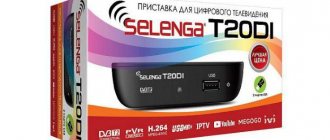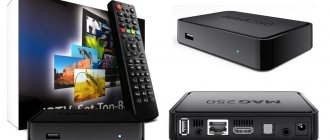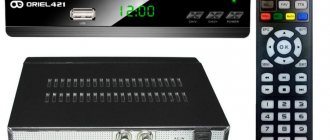QLED vs OLED - in some ways the confrontation between these technologies is reminiscent of the rivalry between plasma and LCD TVs. QLED displays were developed by Samsung employees, almost no one knew anything about them, but such devices very quickly gained the trust of consumers.
However, is QLED really the peak of the development of the television equipment production industry, or is it just a clever advertising gimmick? To answer such a difficult question, let's compare QLED vs OLED to find out which of these technologies is more effective.
SAMSUNG Q7FAMT – 75″ QLED 4K UHD, SMART TV, WI-FI, HDR 1500, WI-FI, HDMI, USB, LAN
Few consumers really know the meaning behind these English abbreviations. Now we will decipher the essence of each technology, analyze their strengths and weaknesses. We will also conduct a test of independent televisions.
What are OLED and QLED
At first, you may get the impression that a TV device based on an organic light-emitting diode (OLED) is extremely similar to LED models. At a minimum, the letters in both abbreviations are almost identical, and they denote identical concepts. Thus, OLED is the same LED, but with components of organic origin.
LEDs allow you not only to generate a picture, but also to illuminate it. Absolutely all pixels determine the color palette and emit a special light.
Philips 9 Series 65in OLED TV
In practice, certain similarities with plasmas that have already gone out of circulation, which consisted of individual cells filled with gas and coated with a special substance, are noticeable to the naked eye. They determined the color gamut of the image and each individual pixel.
However, OLEDs are a more efficient solution because they are able to provide the best contrast among available display technologies. Firstly, the problem with black color is completely solved. For example, if necessary, the pixels are turned off without emitting light at all. This is the main feature of this technology.
OLED matrices on large-diagonal TVs are extremely expensive to produce, and therefore the cost of equipment increases significantly. The LG company, which created this technology, comes out of the situation as follows: OLED matrices are used in Premium segment television devices.
LG 55EF9500 OLED 4K Smart TV
Today, OLED TVs are produced by LG, but also by other popular brands, such as Sony. This type of display is also used in the manufacturing process of mobile phones.
As for QLED technology, this is a development by Samsung. The developers themselves have repeatedly stated that flagship TV models with such a matrix will be able to compete with OLED models.
Quantum dot displays (QLED) are based on a liquid crystal matrix and are also equipped with LED backlighting. In fact, the technology does not have any fundamental differences, and the change in the abbreviation can be called more of a marketing move by Samsung.
However, the modified technology still has certain features. Firstly, QLED displays are based on quantum dots - nanoparticles that emit or change light at different frequencies when interacting with electricity. This kind of light adjustment allows you to choose a suitable color palette from a wide range.
Samsung QE55Q7F
The significantly expanded range is certainly an advantage, but there are doubts about the contrast of such TVs. The matrix in question is not capable of providing rich black color like OLED displays. The fact is that QLED devices have negligible reflectivity at maximum brightness.
Contrast, black depth and viewing angles
Black levels and contrast create the visual perception of brighter colors due to the way the human eye perceives shades. OLED screens are more efficient in achieving maximum contrast and deeper blacks, which leads to a higher-quality image overall - the picture looks more three-dimensional. This happens due to the peculiarities of technology. OLED TVs are TVs that can adjust the brightness of each of its pixels individually, including turning them off completely, allowing for infinite contrast and “pure” blacks.
QLED, as we have already said, belongs to LCD technology and is built on a VA (Vertical Alignment) matrix. The main work involved passing the LED backlight through pixel blocks and color filters to form an image on the TV. Therefore, in an LCD, it is impossible to get black and contrast at the OLED level, due to the LEDs constantly shining through the matrix. In simple words, the crystals block the light, but the backlight continues to work. The light falls on the “black” pixels, which makes the dark image faded.
Possessing super-contrast and full black color, OLED also has the widest viewing angles. QLED panels have a fairly high contrast for LED, but at the same time they lose image quality at the viewing angle. Unfortunately, in liquid crystal technology one excludes the other.
In this category, OLED is the clear leader.
Differences between QLED, OLED and LED technologies
First of all, every buyer should remember that QLED is not an innovative technology, it is rather an optimized version of LED with the addition of quantum dots. Some experts argue that the very concept of “quantum dots” is also largely a publicity stunt, but they are really minimal, their size ranges from 2-10 nm.
The difference between these matrices is that OLED TVs do not have built-in backlighting, while QLED models, on the contrary, are made according to the LED principle, that is, with backlighting.
65 “Q9F 4K Smart QLED TV
Separately, it is worth noting the fact that OLED displays are created on the basis of organic light-emitting diodes, which, by the way, gradually burn out. Naturally, this process of self-destruction proceeds smoothly, but the fact remains that over time the image quality deteriorates. The difference between QLED is the use of a metal base when integrating quantum dots, as a result of which burn-in is prevented.
In OLED, all pixels and sub-pixels can emit light on their own. The technology has not stopped developing, but rather is being improved by developers. For example, modern screens are designed in such a way that each pixel has its own transistor. If necessary, you can turn off the pixel, giving the image a more saturated black color.
When considering the confrontation between OLED vs QLED, parameters such as brightness and color should definitely be touched upon. TVs based on quantum dots produce up to 2000 nits. For HDR 10 or Dolby Vision to work correctly, 1000 nits is enough. OLED TVs lose in this parameter, as they can only offer 700 nits.
OLED matrices have a wide range of colors and high contrast. However, despite the differences in LED backlighting, it is QLED displays that are the leaders in this parameter.
What is the difference between QLED and OLED matrices in displaying moving objects? Motion blur is another important criterion for comparing technologies. 4K TVs can blur the picture as the pixels that form the image try to change color dramatically.
Response time affects how smoothly a TV device processes fast-moving images or blurs the image. The lower the response, the less blur. For LED displays, this parameter varies over a wide range. Many 4K models blur the picture when objects move dynamically. At the same time, Premium class devices, on the contrary, cope with the task perfectly.
In this regard, matrices based on quantum dots perfectly control the dynamic change in the color palette of a pixel, especially with little time response. However, OLED displays are still more efficient in this regard. This statement is explained by the nature of light and the color range that organic light-emitting diodes emit.
The best OLED TVs
The section presents the best OLED TV models in 2021. They are suitable for playing content in 4K, and are characterized by fast response (which is especially important for gamers).
LG OLED55BXRLB 55″
The cheapest TV with OLED technology presented in Russia.
But the price of the device is not its only advantage. In addition to good contrast, the screen has a high refresh rate. This is necessary for viewing dynamic content in HDR and playing games. Connectors (HDMI 2.1 and USB) allow you to connect both the latest consoles and standard media.
Advantages:
- contrast;
- Screen refresh rate – 100 Hz;
- modern connectors;
- sound with a total power of 40 Hz (subwoofer - 20 Hz, 2 speakers 10 W each).
Disadvantages: Smart TV runs on webOS Smart TV.
Sony KD-55A8 54.6″
2021 model with a laconic design.
The mirror screen improves the appearance, and the anti-glare filter effectively eliminates possible defects. The TV stands out for its high contrast and brightness, even among other OLED models. There are many ports for connecting removable media – 4 HDMI 2.1, 2 USB 2.0, 1 USB 3.0
Advantages:
- Android TV;
- bright picture;
- many connectors;
- immersive sound;
- ergonomic design.
Flaws:
- inconvenient access to the bottom connectors (if you hang the TV on the wall);
- the device does not “see” MKV files.
Panasonic TX-55HZR1000 55″
The manufacturer's most budget model released in 2021.
The device is distinguished by quality, cinematic images. The model is equipped with the Dolby Vision IQ function, which automatically adapts the brightness and contrast of the screen depending on the lighting in the room. The TV is also great for watching racing and other fast-moving scenes thanks to BFI technology.
Advantages:
- many ports (4 HDMI0, 2 USB 2.0, 1 USB 3.0);
- automatic brightness and contrast adjustment;
- Improved system to prevent motion blur.
Flaws:
- not the best quality sound (2 speakers 15 W each);
- There is no HDMI1 connector, which gamers need.
LG OLED55CXR 55″
A TV equipped with the closed operating system webOS 5.0.
The model is equipped with Dolby Vision IQ and Dolby Atmos technologies. The first selects optimal brightness and contrast values based on the genre of content and the degree of room illumination. The second is responsible for sound. It is reproduced with the effect of immersion in the atmosphere of what is happening on the screen.
Advantages:
- automatic brightness and contrast adjustment;
- 4 HDMI 2.1, USB connectors;
- very fast response;
- good sound.
Flaws:
- insufficient peak brightness;
- closed OS.
LG OLED65CXR 65″
The model with a larger screen runs on webOS.
The matrix provides a bright image without highlighting individual parts of the screen. The TV is equipped with Dolby Vision technology and supports HDR, which allows you to immerse yourself in the atmosphere of a movie or game. The device is perfect for gaming as the response time is minimal.
Advantages:
- fast OS;
- intuitive and convenient menu;
- quick response.
Flaws:
- high percentage of defects (possible crackling when viewing, streaks appearing on the screen);
- no DTS support;
- Flickering is possible when the Motion pro function is turned on;
- Dolby Atmos only works in supported apps. Without it the sound is flat.
Which manufacturers support OLED and QLED
QLED is a development by Samsung, so displays with such a matrix are found mainly in this South Korean manufacturer. As for OLED technology, it was created by the efforts of LG, but is also found in other popular manufacturers, for example, Sony.
Which is better to choose LG OLED or Samsung QLED? The results of independent testing show that the manufacturer only indirectly affects the performance characteristics of television equipment. To a greater extent, the final decision depends on the individual parameters of a particular model: diagonal, resolution, GPU frequency, etc.
LG E6 OLED 4K HDR Smart TV
Color space and peak brightness
The biggest improvement that can be seen in the quantum dot technique is the improvement in color rendering. Samsung has taken a big step towards achieving a wider color gamut with its proprietary Quantum Dot technology. However, this does not mean that OLED is significantly inferior in terms of color rendering; the difference is very insignificant and we can say that Organic Light Emitting Diode is practically stepping on the toes, that is, many users practically cannot distinguish this difference by eye.
As for the maximum brightness levels, in this matter, if you look strictly at measurements from popular resources, the advantage of LCD QD TVs at first glance seems more obvious, but this is not entirely true. Despite the fact that OLEDs cannot achieve the same peak brightness on test slides, in reality, on real content (especially when watching movies), the readings are quite comparable on both technologies. In this matter, QD-LED has only one advantage; unlike OLED, it does not have an automatic brightness limiter (ABL), that is, in bright scenes over a larger screen area it does not dim, as happens on an organic screen.
Therefore, in this category, QLED has the advantage.
Who will win
The main parameters of all types of display matrices have been reviewed, which means it’s time to answer the most important question - which technology will provide the best quality, and which TV is worth buying? If your budget allows, then give preference to a model with an OLED matrix.
However, if you want to choose a TV with the optimal price/quality ratio, or you are interested in a specific parameter (brightness, color reproduction), then the new 4K TV device from Samsung will look like a preferable option.
If we talk about ordinary 4K LED TVs with HDR support, of which there are much more in electronics supermarkets, then they will also cope with the reproduction of ordinary media content.
How QLED TVs work
QLED is essentially an advanced version of LCD technology with LED backlighting. There used to be debate about which is better: LCD TVs or plasma panels. LCD technology has triumphed and today dominates the television market. In these TVs, LEDs function as a backlight that transmits images through the LCD display.
But there's a big problem with LED LCD TVs: the backlight color and picture quality on the LCD screen can vary. QLED tries to solve this problem by placing a thin layer, called a quantum dot filter, between the LED backlight and the LCD screen (quantum is where the "Q" comes from). The quantum dot filter purifies the light emitted by LEDs to produce better, brighter, more intense color.
LED LCD what is it?
These types of monitors are quite common. They have a number of characteristics, and also have a variety of models, distinguished by monitor size. To understand their nuances, you should find out what the term LED LCD itself means.
So, LCD is understood as a panel that includes several sheets of a special material, between which a special solution is placed.
LED is one of the backlights for LCD panels, which is based on the activity of LEDs.
In other words, LED LCD is a liquid crystal monitor that has LED backlighting. As a result, the picture on such a screen is brighter and more saturated in quality.











